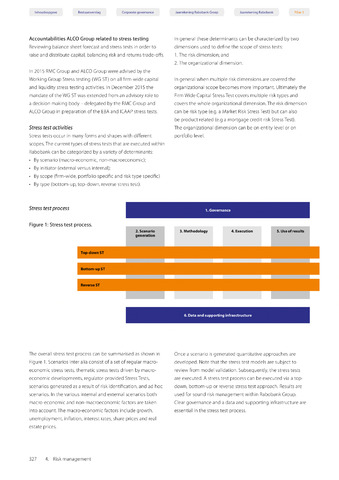Inhoudsopgave Bestuursverslag Corporate governance
Accountabilities ALCO Group related to stress testing
Reviewing balance sheet forecast and stress tests in order to
raise and distribute capital, balancing risk and returns trade-offs.
In 2015 RMC Group and ALCO Group were advised by the
Working Group Stress testing (WG ST) on all firm-wide capital
and liquidity stress testing activities. In December 2015 the
mandate of the WG ST was extended from an advisory role to
a decision making body - delegated by the RMC Group and
ALCO Group in preparation of the EBA and ICAAP stress tests.
Stress test activities
Stress tests occur in many forms and shapes with different
scopes. The currenttypes of stress tests that are executed within
Rabobank can be categorized by a variety of determinants:
By scenario (macro-economic, non-macroeconomic);
By initiator (external versus internal);
By scope (firm-wide, portfolio specific and risk type specific)
By type (bottom-up, top-down, reverse stress test).
Jaarrekening Rabobank Groep Jaarrekening Rabobank
In general these determinants can be characterized by two
dimensions used to define the scope of stress tests:
1The risk dimension; and
2. The organizational dimension.
In general when multiple risk dimensions are covered the
organizational scope becomes more important. Ultimately the
Firm Wide Capital Stress Test covers multiple risktypesand
covers the whole organizational dimension. The risk dimension
can be risk type (e.g. a Market Risk Stress Test) but can also
be product related (e.g a mortgage credit risk Stress Test).
The organizational dimension can be on entity level or on
portfolio level.
1. Governance
Stress test process
Figure 1Stress test process.
2. Scenario
generation
3. Methodology
4. Execution
5. Use of results
Top-down ST
Bottom-up ST
Reverse ST
6. Data and supporting infrasctructure
The overall stress test process can be summarised as shown in
Figure 1. Scenarios inter alia consist of a set of regular macro-
economic stress tests, thematic stress tests driven by macro-
economic developments, regulator-provided Stress Tests,
scenarios generated as a result of risk identification, and ad hoc
scenarios. In the various internal and external scenarios both
macro-economic and non-macroeconomic factors are taken
into account.The macro-economic factors include growth,
unemployment, inflation, interest rates, share prices and real
estate prices.
Once a scenario is generated quantitative approaches are
developed. Note that the stress test models are subject to
review from model validation. Subsequently, the stress tests
are executed. A stress test process can be executed via a top-
down, bottom-up or reverse stress test approach. Results are
used for sound risk management within Rabobank Group.
Clear governance and a data and supporting infrastructure are
essential in the stress test process.
327 4. Risk management

